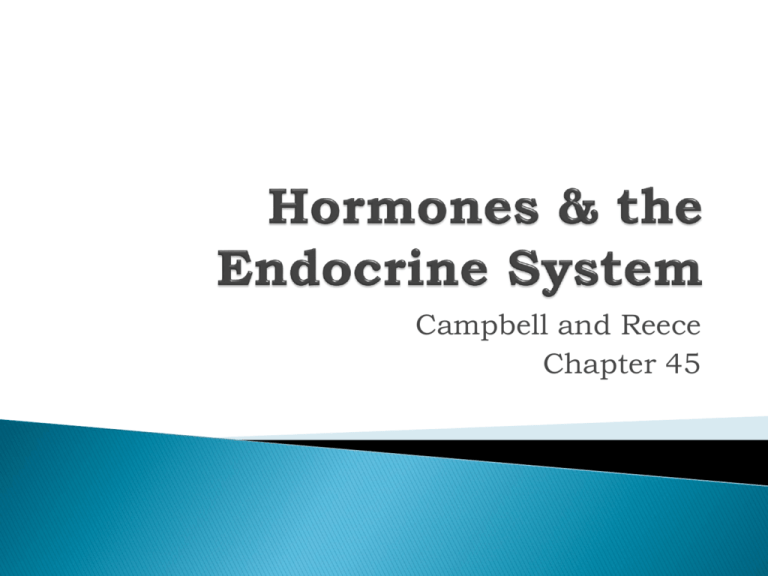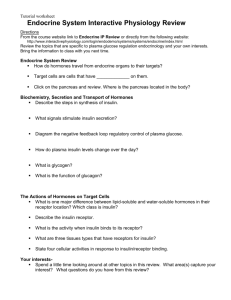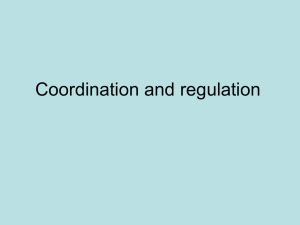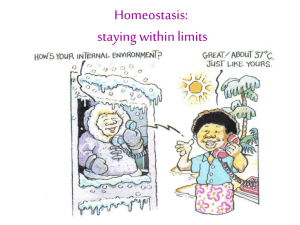Hormones & the Endocrine System
advertisement

Campbell and Reece Chapter 45 body‘s long-distance regulators molecules secreted into ECF circulate thru body communicate regulatory messages thru out body in animals that undergo metamorphosis hormones stimulate growth of adult cells & apoptosis of larval cells with nervous system in charge of communication & regulation thru out body rapid response neurotransimitters short distances regulate neurons, muscle, glands, endocrine cells (area of overlap) Nervous System slower response hormones short or long distances regulate functions of most organ systems Endocrine System signaling processes in animals: classified by 2 criteria: 1. type of secreting cell 2. route signal takes to reach target hormones ECF bloodstream target cells functions: 1. maintain homeostasis 2. mediate responses to environmental stimuli 3. regulates growth & development molecules that act over short distances reach target solely by diffusion ◦ ex: cytokines released by T helper cells 2 types: 1. paracrine 2. autocrine http://sites.sinauer.com/cooper5e/anima tion1501.html not all secreted molecules act w/in body method of communication between members of some animal species ◦ ex: 1. foraging ant locates new food source marks its path back to nest with pheromones 2. define boundaries of territory 3. attract mates: female giant silk moth releases pheromone that can attracgt a male up to 4.5 km away ductless organs secrete hormones directly into surrounding fluid 1. 2. 3. Polypeptide Steroid Amines secreted by exocytosis travel thru blood bind to cell-surface signal receptors induces changes in cytoplasmic molecules might alter gene transcription (signal transduction) Water-Soluble diffuse out of endocrine cell bind to transport molecules in blood diffuse into target cells bind to intracellular receptors trigger gene transcription Lipid-Soluble effects hormone has can vary if target cells differ in molecules that receive or produce the response to the hormone pathways by which local regulators trigger responses same as those activated by hormones growth factors ◦ stimulate cell proliferation & differentiation NO (nitric oxide) ◦ synthesized & released by endothelial cell when O2 levels low activates enzyme in smooth muscle vasodilation increased blood flow prostaglendins: ◦ aggregation of platelets blood clotting ◦ promote fever & inflammation in immune system ◦ smooth muscle contraction occurs in all but simplest invertebrates stimulus initiates a response that will reduce the effect of the stimulus Negative Feedback stimulus initiates a response that reinforces the stimulus Positive Feedback Insulin lowers blood glucose levels by: ◦ stimulating nearly all cells *outside the brain to take up glucose ◦ slowing glycogen breakdown in liver ◦ inhibiting glycerol (from fats) & a.a. glucose aka gluconeogenesis *brain cells do not require insulin to take up glucose Glucagon influences blood glucose levels mainly thru it effects on target cells in liver when serum glucose levels < normal (70 – 110 mg/100 mL) glucagon signals liver cells to release glucose blood by: 1. increase glycogen hydrolysis 2. convert a.a. & glycerol glucose deficiency of insulin in target tissues hi blood glucose levels but cannot get into cells so cells use fat as main substrate for cellular respiration acidic metabolites form during fat breakdown ketoacidosis ◦ low pH can be life threatening ◦ Na+ & K+ ions depleted characterized by failure of target cells to take up insulin from blood elevated blood glucose 7th most common cause of death in USA contributing factors: ◦ genetics (defect in insulin receptor or insulin response pathway) ◦ obesity ◦ age (though more children being diagnosed) ◦ sedentary lifestyle Hypothalamus ◦ plays central role in integrating endocrine & nervous systems ◦ receives info initiates endocrine signaling appropriate to environmental conditions ◦ sends releasing hormones to anterior pituitary gland sends tropic hormones to target glands ◦ sends hormones it makes to posterior pituitary ADH: antidiuretic hormone (vasopressin) 1. ◦ ◦ 1 of several hormones that act on kidneys increases water retention in kidneys (decreases urine vol/ increases blood plasma vol : maintains blood osmolarity wnl Oxytocin 2. ◦ ◦ increases strength on uterine contractions in labor regulates milk secretion by mammary glands over time functions of a hormone have diverged from species to species ex: thyroxine (thyroid hormone) regulates metabolism in most animal but in frogs it function to resorb tadpole tail Prolactin: in mammals develops mammary glands & milk production but in birds: regulates fat metabolism & reproduction; in amphibians: delays metamorphosis; in fish Animal Mammals ` Birds Amphibians Fish ` Function develops mammary glands & milk synthesis regulates fat metabolism delays metamorphosis regulates salt & water balance









